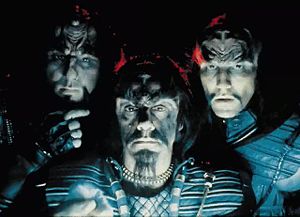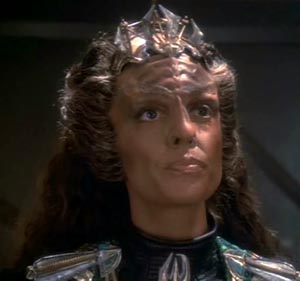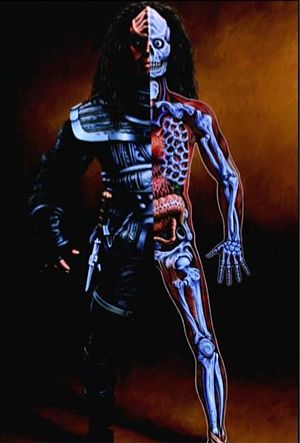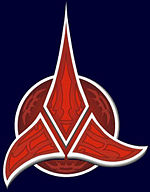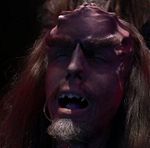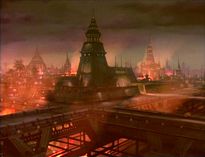Klingon
| SPECIES | |||
|---|---|---|---|
| Homeworld: | Qo'noS | ||
| Quadrant: | Beta | ||
| Affiliation: | Klingon Empire | ||
| Biology | |||
| Average Male Height: | 168 cm (5 ft. 6 in.) to 203 cm (6 ft. 8 in.) | ||
| Average Male Weight: | 59 kg (130 lb.) to 127 kg (280 lb.) | ||
| Average Female Height: | 168 cm (5 ft. 6 in.) to 203 cm (6 ft. 8 in.) | ||
| Average Female Weight: | 59 kg (130 lb.) to 127 kg (280 lb.) | ||
| Minimum Academy Age: | 18 | ||
| Life Expectancy: | 150 | ||
| Distinctive Features: | |||
| Playability | |||
| PRC Rated: | Yes | ||
| NPC Rated: | Yes | ||
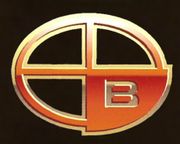 | |||
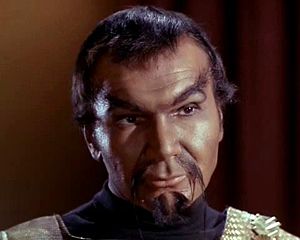
- Note: This is a PC and NPC rated species.
The Klingons (Klingonese: tlhIngan) are a humanoid warrior species that originates from the planet Qo'noS (pronounced Kronos), an M-class planet. One of the major powers of the galaxy, the Klingons are a proud, tradition-bound people who value honor and combat. The aggressive Klingon culture has made them an interstellar military power to be respected and feared. Klingons believe that they have the instinctive ability to look an opponent in the eye and see the intent to kill.
Contents
Physiology
Klingons are known to be very strong and resilient physically. They resist diseases and injuries much better than their human counterparts. The ability is due to a characteristic called “brak’lul”. brak’lul refers to the system of redundancies within the Klingon physiology. The most common misconception of this is that Klingons have multiple organs that are redundant to each other, such as 2 hearts, 4 kidneys, 4 lungs, etc.
While the idea of multiple redundant organs is incorrect, it is not far from the truth. In actuality, the Klingon body does incorporate multiple redundancies for almost all of the vital functions. This is done by a lobe/chamber duplication, rather than full organs. For example, a human heart contains 4 chambers. In Klingons there are 8 chambers. Lungs would be 4 lobes, instead of 2 like humans, and so on. They have twenty three ribs (arranged in a sort of latticework). Some geneticists believe the redundancy within the organs, notably the lungs, evolved to give Klingons greater stamina on the battlefield.
Interestingly, there are departures from this pattern, most notably in the Klingon reproductive system. While human males possess 2 testicles, and females 2 ovaries, in Klingons males have 3 testicles, and females 3 ovaries. Similarly, The Klingon eye is protected from damage by a third, transparent eyelid.
Klingons have never been seen to cry. This is due to the fact that they do not possess tear ducts. However, this does not mean a Klingon cannot feel sadness, anger, or happiness. Klingons simply express their emotions differently. This usually involves screaming, singing, long periods of silence, etc.
Physically, Klingons have evolved over generations of living in the harsh environment of the Klingon homeworld. Though the Klingon homeworld has oceans and water on it, the land is typically dry and barren. Due to this, Klingon feces and urine do not have anything in common with their human counterparts. Klingon feces look like dried up cakes. This occurs because their body claims as much moisture as possible from their food and drink. Similarly, Klingon urine is much more thick, salty, and acidic.
The Klingon musculoskeletal system is as unique as the rest. The longer bones in the legs and arms are stronger than humans due to reinforcement by a secondary, slightly shorter bone. For example, instead of one humerus or femur (upper arm or upper leg) as in humans, Klingons have two bones in each.
The Klingon cranium is twice as thick as a human skull. This feature was specifically designed to protect the brain when receiving a blow to the head. Klingon foreheads contain ridges due to the skull having outgrowths on the frontal lobe. Interestingly, the forehead is not the only place where a Klingon possesses ridges. There are similar ridges running along the sternum, spine, and feet. In addition, the first metatarsal bone that leads to the big toe has an outgrowth on it. These growths on the Klingon skeletal structure have lead scientists to believe that at some point in the past, Klingons may have needed the additional protection on vital bone structures, and or may have had additional attributes that would help in a fight.
With reference to the skeletal system, the Klingon vertebrae are much thicker, which make it harder to be injured in battle and the hips are thicker to support the weight of the larger torso and organs, as well as to prevent hip injuries. The chest cavity holds 23 ribs [11 matched pairs, and 1 extra rib] in comparison to humans, which hold 10 pairs of ribs, and 2 pairs of floating ribs. There is no data on what the extra rib in a Klingon is there for, but it is presumed to offer some protection to organs in the upper abdomen.
A Klingons blood in most cases tends to be a thicker, pinker color often referred to as “pepto-bismal” where human blood is thinner and more red or purple. No explanation has been made for this.
Common Klingon Terms (relating to physiology)
nach = head
rol = beard
jIb = hair
Quch = forehead
ghIch = nose
qah = face
mIn = eye
nuj = mouth
volchaH = shoulder
ghop = hand
DeS = arm
nItlh = finger
ro'= fist
ro = torso
burgh = stomach
qIv = knee
'uS = leg
qam = foot
Gestation & Maturation
Information in this area is not entirely clear. There are considerations that it can range from 110 days (Just under 4 months) to 30 weeks.
After taking into consideration the varying factors; parental heritage, and genetics, physicians have estimated that the average 'normal' Klingon gestation period is about 5 months. Some are perhaps shorter due to complications, some longer if the Klingon genetic influence is lower. Due to the shorter term, the vascular system is much quicker and the mother and baby are linked by a complex network of blood vessels (roughly a similar type situation to the Bajorans).
If the pregnancy is of mixed blood, the pregnancy will split the difference and the mixed heritage pregnancies generally need medical assistance to go full term. Examples of canon hybrids: Human/Klingon and Romulan/Klingon. Any other hybrid would have to have genetics taken into consideration.
Klingon twins are very rare, but could be as random as any species (Unless specific intervention is the cause). The Klingon female will most likely suffer from behavioral volatility, backaches and nausea during the pregnancy, but that doesn't stop them from attending to their duties.
Aging
Another subject of Klingon genetics, which has not received much attention, is the subject of maturation and aging. Using Worf's son, Alexander, and Kor, Kang, and Koloth as examples - Klingons appear to have an interesting aging process.
Alexander was conceived in The Next Generation episode “The Emissary”, calendar date 04/08/2365, and born on the 43rd day of Maktag, calendar date 07/28/2365. Based on these dates, Klingons have a gestation period of approximately 110 days, just under 4 months.
Worf first met Alexander when he came to the Enterprise with his mother in the episode “Reunion”, calendar date 08/11/2366. A little over a year after his birth, the with K`Ehleyr appears to be approximately 3-4 Earth standard years old. Alexander appeared in later episodes of The Next Generation, again appearing older than the timeline would account for. We are reintroduced to Alexander in the Deep Space Nine episode “Sons and Daughters”, calendar date 6/27/2373. Even though this is only eight years after his birth, Alexander is considered old enough to be a member of the Klingon Defense Forces and appears to be in his late teens/early twenties.
Looking at the changes in Alexander from his conception on 04/08/65 to his appearance in Deep Space Nine on 06/27/73 it would appear Klingons mature at a rate 2 to 2.5 times faster than Humans.
This faster maturation rate leaves us with another problem though. In the Deep Space Nine episode “Blood Oath”, calendar date 01/15/2370, we are re-introduced to the Klingons from the Original Series: Kor, Kang and Koloth.
Kor appeared in the Original series episode “Errand of Mercy”, calendar date 07/25/2265; Kang appeared in “Day of the Dove”, calendar date 04/08/2266; Koloth appeared in “The Trouble With Tribbles”, calendar date 11/20/2266. These episodes occurred 104 years before “Blood Oath”. If Klingons indeed mature at a rate of 2 to 2.5 times faster than Terrans then Kor, Koloth and Kang would have been the equivalent of a Human well over 200 years old.
Since Klingons apparently have a fairly long life span, we must factor this in as well. Based on the fast maturation process of adolescent Klingons and the long life expectancy of adults, those who do not die in battle, it appears, go through several metabolic changes during their lives. So, while Klingons do mature faster than Humans at some point they start to age at a rate slower than the average Human.
Klingon Medical Science
Klingon medicine is at least as advanced, if not more so, than humans. However, even having the capability to heal easily, Klingons do not use this knowledge to unnecessarily prolong the life of someone, nor do they use it to give comfort to the ill or dying.
Klingons tend to use natural remedies such as herbal remedies whenever possible, however, space travel has forced the necessity to use technology while underway. If a remedy fails, then the sick person is either left to die or to heal themselves through the Klingons’ naturally strong constitution, depending on the situation.
In some situations, a more barbaric form of medicine is practiced. As an example, a Klingon is injured by cut or stab, but is not dying. The Klingon may use “traditional” methods of medicine to suture or patch the wound. This can be seen on General Chang with the eye patch bolted to his head, or Chancellor Martok whose injured eye appears to be sewn shut with a large rather nasty scar across it. Damaged limbs tend to be amputated if they are infected and/or not healable. This prevents the spread of infection
Diseases
The Klingons suffer from numerous diseases namely:
Medical Equipment
The following equipment is used by Klingon medics. Please be aware that this is not Star Fleet equipment.
Psychology
Thank you to P.B. (Derrick Grant) for writing this section of the article.
Klingons are a proud race. That is not to say that they are arrogant and lack humility; quite the opposite in fact. Klingons have humility in abundance. But they do not SHOW it unless necessary. This is because of the nature of the Klingon psychology, which like every part of Klingon culture and history, is filled with rituals to demonstrate strength and ability to survive.
Qo’noS is a hostile and nearly inhospitable world for most species. Its environment as well as the fauna that evolved there are all very aggressive; and the Klingon species, from its earliest ancestors to the current, have evolved to accommodate this, including their psychology. Because of this, their psychology has also evolved into one that embraces their rituals and rites, many of which are designed to demonstrate strength and endurance.
Klingons are also passionate and fanatical about BEING Klingon. Typically they wear their honor and the honor of their comrades and family or “house” as a badge of achievement. And anything that tarnishes that honor, or even gives the appearance of doing so, is considered shameful and embarrassing. For this reason, a Klingon tends to be very sensitive about this, and will react passionately and often violently to any challenge to the honor of them, their comrades, their family, or their ‘house’. A ‘house’ is similar to an Andorian ‘clan’ or another species’ extended family unit. While all members of a house might not be ‘blood relatives’, they consider one another as brothers and sisters just as though they were. And an insult to one member of a house is an insult to all members of that house. Do not challenge a Klingon’s honor or authority without good cause.
Klingons are also a people who value honesty and directness. This is evident in their language and actions. When a Klingon greets you, or you greet him/her, be direct! Do not ask them how their day is going—unless you are there to discuss the events of the day. Do not talk about the weather—unless it is relevant. To a Klingon, indirectness is equivalent to dishonesty, and you will be treated as untrustworthy if you are not direct.
Most Klingons will deny any illness or minor injury until and unless they have no choice but to do otherwise. Even then, they will resist all except the most basic ‘triage’ type treatment, insisting (and quite accurately in most cases) that their body can fight off disease, illness, or injury on its own. The Klingon psychology has thus developed a very high resistance to pain and physical discomfort, and they tend to not complain about such things. They also tend to avoid and dislike medical professionals and their workspaces, as they feel little need for the doctors.
As a Klingon might say, “If I am too ill/injured to fight off my illness, then allow me to die with honor, rather than live with disability.”
Klingon psychology is consistent from a very young age. Klingon children tend to be more outwardly violent than their counterparts from other worlds. They play rough, they become injured often, and they keep going when they do get hurt. Their violence is not intentional—it is simply millennia of genetic training. Klingons evolved violent, because they come from a violent world.
As Klingons age, they tend to become somewhat less aggressive, however many end up very bitter at the universe for having deprived them of their rightful honorable death and place in their ‘heaven’ also known as Sto-Vo-Kor. They are often shunned by others in their society, and this adds to the bitterness. As a warrior race, they believe it is their DESTINY to die in battle, and old men are rarely on the front lines of battle. Some Klingons, when they get older, realize that they have lived full and satisfying lives, and instead opt to live quietly until their end.
In conclusion, the Klingon mind is as complex as the rest of their body and culture, and one cannot make a short study of Klingon psychology any more than one could of any psychology and still be comprehensive and all-inclusive.
Society
Klingon society is extremely complex. It is based on a feudal system organized around traditional Great Houses of noble lineage, to which various parts of the population owe fealty. The Great Houses are traditionally represented in the Klingon High Council, which is led by a Chancellor.
Males traditionally dominate public life in the Empire, assuming the leading roles in politics and the military with only rare exceptions. A notable exception of the prohibition of women serving on the High Council came when Azetbur became Chancellor of the High Council after her father, Gorkon, was assassinated in 2293. Women, in turn, traditionally dominate the household and the management of the family's affairs. Klingon women are treated as equals except in politics and matters of inheritance. They are prohibited by law from serving in the High Council and cannot take control of their Houses unless they have the money and no male successors of the lineage. Otherwise, it is expected of Klingon women to exhibit the same physical prowess and lust for blood and honor as the men.
Klingon society functions through a system of family reputation and honor. Tradition is an integral part of their lives and breaking from observances is considered a grievious insult to society that is not forgotten easily, bringing shame to the offender's name for several generations. Bloodlines and relations are also taken very seriously by any true Klingon. Lines comprise of more than mere family members.
An integral part of tradition is the various rituals that mark milestones in a Klingon's life or the history of the Empire. Most notable of the rites is the Rite of Succession, which a future leader of the Empire must complete with a valid Arbiter of Succession (Captain Jean-Luc Picard in the case of Gowron) overseeing the proceedings. Before the Rite can begin, there's another elaborate ceremony needed to confirm the death of the previous leader. This is known as the Sonchi ceremony. Individual Klingon warriors are expected to go through the Rite of Ascension to be recognized as a full adult.
Klingons are extremely territorial. There is no such thing as an "insignificant corner of Klingon space".
Klingon warriors generally do not wear rank insignia on their uniforms. A Klingon would never claim to be any other rank than what they actually are, since this would be an egregious violation of a warrior's honor code. If a Klingon claims to hold a specific rank, they can be taken at their word.
Religion and Tradition
Ritual is a very important element in Klingon society. The Klingons are not a religious people as such - they do believe that deities existed at one time, but the Klingons slew their gods about a thousand years ago as they were considered to be more trouble than they were worth. They believe that once a Klingon has died the spirit exits the body, leaving behind a worthless shell to be disposed of. In the Klingon death ritual, it is traditional for those on hand to howl into the sky as a warning to the afterlife that a Klingon warrior is about to arrive. In some cases a funeral dirge is sung in memory to the deceased, or friends will sit with the body to protect it from predators, a practice known as Ak'voh.
Furthermore, a Klingon, who is unable to fight, hence is unable to live as a warrior anymore, has the traditional obligation of committing the Hegh'bat, which is the Klingon ritual suicide. Tradition dictates that a close friend, or eldest son must assist. That person's role is to hand the dying Klingon a knife so that he can plunge it into his heart, remove it and then wipe the blood on his own sleeve.
The Klingon afterlife is divided into two branches; the dishonored are taken to Gre'thor aboard the Barge of the Dead, a vessel captained by Kortar, the first Klingon. Kortar was the one who originally killed the gods who created him, and was condemned to ferry the dishonored to Gre'thor as a punishment. Once in Gre'thor, the dishonored are watched over by Fek'lhr, a vaguely Klingon-esque figure. It is tempting to view Fek'lhr as the Klingon equivalent of the Human devil, but according to Kang, the Klingons have no devil.
Those who die honorably go to Sto-vo-kor, where Kahless was said to await them.
Klingon rituals include the R'uustai, a bonding ceremony which joins two people together in a relationship similar to brotherhood. Klingon tradition holds that "the son of a Klingon is a man the day he can first hold a blade."
If a Klingon warrior strikes another Klingon with the back of his hand, it is interpreted as a challenge to the death. Klingon warriors speak proudly to each other; they do not whisper or keep their distance. Standing far away and whispering are considered insults in Klingon society.
When going into battle, Klingon warriors often sing the traditional warriors' anthem, which is essentially an invocation to Kahless and a pledge to win a good death in battle.
Food and Beverages
- Bahgol
- Bloodwine
- Bregit lung
- Chech'tluth
- Firewine
- Gagh
- Gladst
- Grapok sauce
- Heart of targ
- Klingon martini
- Pipius claw
- Racht
- Rokeg blood pie
- Raktajino
- Warnog
- Zilm'kach
History and Politics
The Klingon Empire was founded sometime in the ninth century CE by Kahless the Unforgettable, who performed many heroic feats including the unification of the Klingon people when he killed the tyrant Molor. Kahless came to be revered in Klingon society to the point of near-deification, and many aspects of Klingon culture came to revolve around emulation of Kahless's life.
The warrior ethos has been an important aspect of Klingon society since the time of Kahless, but the warrior aspects became much more dominant beginning in the early 22nd century. Previously, Klingon society was regarded as socially balanced, but over time the warrior caste gained greater prominence, to the point where the Klingons widely came to be regarded as a "warrior race."
Because of their aggressive outlook, the Klingons have generally had poor relations with other species after they began to move out into space. Because the worlds of the Klingon Empire are resource-poor, the Klingons have developed an intense belief in the need for expansion and conquest in order to survive. The Klingons' relationship with Humans and the Federation has been rocky at best. Following the disastrous First Contact between Klingons and Humans, tense rivalries and unavoidable conflicts often developed between the two species.
In the year 2154, the Klingons gained access to the genetic material of human Augments, and tried to adapt this genetic engineering to improve themselves. An unanticipated side effect was that the Augment DNA caused the cranial ridges to dissolve. The test subjects did gain increased strength and intelligence, but then their neural pathways started to degrade and they died in agony. One of the subjects was suffering from the Levodian flu, which was modified by the Augment genes to become a deadly, airborne plague that spread rampantly among the Empire, from world to world. In the first stage of this plague, Klingons lost the ridges on their foreheads and began to look more human-like.
With the help of a Klingon scientist named Antaak, Dr. Phlox of the Earth starship Enterprise NX-01 was able to formulate a cure that halted the genetic effects of the virus in the first stage, retaining the changes in appearance along with some minor neural re-ordering, but with no development of stage two characteristics, such as enhanced strength, speed, or endurance. This left millions of Klingons, mostly in the warrior caste, without their ridges. These alterations were even passed on to their children.
Klingons were apparently so embarrassed by the fallout from their failed attempt at genetic enhancement that they refused to discuss the incident with outsiders. Due to the secrecy of the Klingon Empire, knowledge of the change became lost over time to the general population of the Federation. By the 24th century, the reason for smooth forehead Klingons was not widely known outside the Empire, and questions were generally met with a brusque answer along the lines of "we don't discuss it with outsiders".
In the year 2218, an incident occured between the Federation and the Klingon Empire which caused the two powers to become adversaries. By 2223, relations between the two powers had degenerated to a point of unremitting hostility, which would last for several decades.
The lingering tensions between Klingons and humans continued to rise, eventually leading to the Battle Of Donatu V near Sherman's Planet in 2245, and later erupted into what was considered the first Federation-Klingon War in 2267, that was quickly ended by intervention by the Organians after only four days of fighting. Over the next several decades, an uneasy peace developed that was broken by brief but fierce skirmishes and conflicts. A true and lasting peace finally came in 2293 with the signing of the Khitomer Accords, thanks to the efforts of Chancellor Gorkon and the Human Star Fleet officer James T. Kirk. Since then, despite several periods of rocky relations, the Federation and the Klingon Empire have been steadfast allies, especially in the face of Dominion aggression in the 2370s.
The Klingon relationship with the Romulan people is also extremely unstable. A short-lived alliance and technology exchange notwithstanding, the Romulan Star Empire has been typically regarded by the Klingons as a "blood enemy" since at least the 23rd century. Sporadic Romulan attacks against Klingon colonies, such as the Khitomer Massacre, and interference in Klingon affairs, such as the Klingon Civil War, have continued to sour relationships between the two peoples.
According to Daniels, a time-travelling Star Fleet officer, the Klingons would join the Federation by the 26th century.
Please see Klingon Empire for more information.
- Note: Some information provided by http://www.kdfs.org
